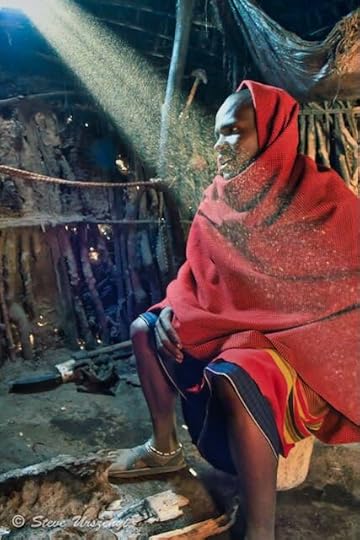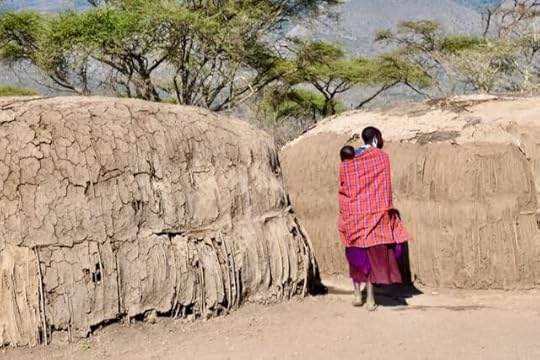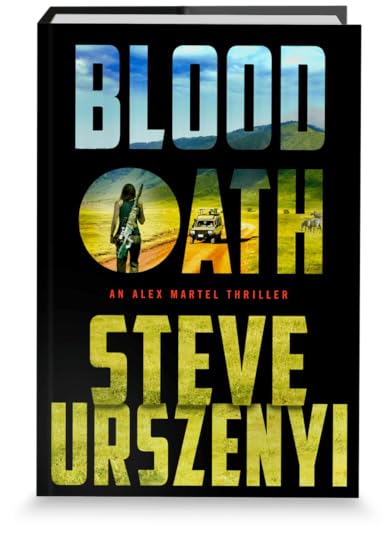Into the Heart of Africa: Part 4

Some encounters change you forever. Meeting Sanka, the chief’s son, was one of those moments—a glimpse into an ancient world that would stay with me for years to come, opening my curiosity to his people’s struggles and shaping the role of the Maasai in Blood Oath.
It was Tuesday morning, June 11th, and we’d gotten to sleep in a little—not leaving the lodge until 8 AM. Our first stop was a Maasai village where we were greeted by a young man whose wisdom and dignity would stay with me for years to come, sparking my curiosity about his people’s struggles and shaping the role of the Maasai in Blood Oath.
The Chief’s SonSanka approached us with the confident stride of someone born to leadership. Son of the village chief, he wore the traditional red, green, and black shuka that marked him as Maasai, his bearing both proud and welcoming. As he taught us about his people’s way of life, I was struck by something that would later become central to Blood Oath: how true authority comes not from force, but from the respect earned through wisdom and sacrifice.
In the novel, when Alexandra Martel first encounters the Maasai warrior Lemarti, she recognizes this same quality—the kind of leadership that emerges from protecting something larger than yourself, even when that protection comes at terrible personal cost.
Warriors Who Jump Higher Than LionsThe men and women were dressed in colorful clothes adorned with intricate beadwork, and they sang as the men prepared to perform the traditional hunting dance. The harmony of their voices filled the air, creating an atmosphere that belonged more to legend than to the modern world. As the Maasai men formed a semicircle, their voices rising in ancient chants, they began the adumu—the jumping dance that has tested warrior strength for centuries.
The men were jumping to show they could jump higher than a lion, I wrote in my journal, to show what good warriors they were and to attract more wives.
This wasn’t just performance—this was proof of worthiness. In Maasai tradition, the warrior who jumps highest demonstrates the strength needed to leap over fences during cattle raids, the agility required to escape predators, the explosive power that might mean the difference between life and death on the savannah.
Then they invited me to join the jumping.
An Honor and a HumblingStanding in that circle of warriors, trying to match their leaps while my middle-aged, worn-out ex-paramedic joints protested every attempt, I experienced something profound. For those few minutes, I wasn’t a tourist or an observer—I was a participant in a ritual that connected these men to their ancestors, to their land, to their identity as protectors.
“He did a pretty good job,” my journal notes Sanka declared diplomatically. The truth was more humbling and more meaningful: I was being welcomed into something sacred, even as my pathetic attempts at jumping made clear how far I fell short of their standards.
Ancient Technologies, Eternal WisdomAfter the dancing, the men demonstrated how to start a fire using only sticks and donkey dung—a technique unchanged for millennia. Watching skilled hands coax flame from friction, I realized I was witnessing the accumulated wisdom of a people who had survived in one of Earth’s most challenging environments.

Sanka then led us into his home, a circular hut with an entry that curved around the exterior to keep out the wind. Inside, everything served multiple purposes: beds made from large sticks with cow hide stretched over top, a central fire pit for cooking and warmth, a square hole in the roof for smoke to escape and light to enter.
“The women build the homes,” Sanka explained as we ducked through the low doorway. “The men bring the large sticks which form the framework, then it is covered with cow dung and water to form a ‘clay’ cover—this is done by the women. This makes the house water- and windproof.”
Family Structures, Ancient and ComplexSanka’s family structure reflected Maasai traditions that stretch back centuries. He had two wives and four children—two boys and two girls. His father, the chief, had eight wives. In Maasai culture, polygamy isn’t just accepted—it’s practical. With cattle requiring constant attention and children needing care, multiple wives ensure the family’s survival and prosperity.

The village itself was a testament to this communal approach: about 120 people, all family members, tending about 150 cattle. In the center of the village, they had set up a small marketplace selling beadwork and traditional crafts.
It was here that the encounter turned personal—and where the seeds of Blood Oath’s themes took root.
The Talking Stick and the Price of ConnectionAmong the items we purchased was a talking stick made of ebony and beads. Sanka explained its significance: “When a mom or dad is holding the talking stick, a child must stop what they are doing and come over to hear what they have to say.”

It was a physical symbol of parental authority, of the unbreakable bond between generations, of the responsibility that comes with being trusted with another’s well-being. In Blood Oath, the relationship between Alex and her father, General David Martel, embodies this same sacred responsibility—the obligation to protect those we love, regardless of the cost.
Education and the Price of ProgressAt the village school, we watched children demonstrate their English alphabet and numbers. They were taught both English and Kiswahili—preparation for a world beyond the village. Sanka explained their educational path: village school, then exams, then boarding school for elementary and high school, possibly university. But wherever they went, they frequently returned to support their families.
Some go on to university—wherever they go, they come back to the village to support their family with the money they can make, I noted in my journal.

This tension between tradition and modernity would become central to Blood Oath. How do you preserve what matters while adapting to survive? How do you honor your ancestors while preparing for a future they never could have imagined?
A Gift and a RecognitionAs we prepared to leave, Sanka gave us a gift—a carved giraffe, probably because we had purchased so much from the village marketplace. In return, we offered him a Cadbury chocolate bar for the children.
James, our guide, approved. “That was a very good thing to do,” he said.
This exchange—practical support disguised as gift-giving—captured something essential about the relationship between the Maasai and the modern world. The tribe had to buy water to fill large tanks, money that came from tourism, from selling their crafts, from the difficult navigation between maintaining their way of life and surviving in a cash economy.
The Diet of WarriorsJames shared a crucial detail about Maasai culture: “Their diet is strictly meat and milk from their cows—no vegetables or fruit (they’re not farmers).” Yet Sanka told us that because they lived close to the city, the government sold them corn, which they made into porridge.
Even their diet reflected the pressure between ancient ways and modern necessities. These were people adapting to survive while fighting to preserve their essential identity.
The Foundation of Blood OathOur encounter with Sanka and his family became the emotional and moral foundation of Blood Oath. The novel’s central conflict—between preserving what we value and adapting to survive—mirrors the challenges facing the Maasai today. The honor codes that drive Alex’s desperate mission to save her father echo the warrior traditions that still guide Maasai society.
Most importantly, that talking stick became a symbol that runs through the entire novel: the sacred responsibility we bear for those we love, the unbreakable bonds that define us, the prices we pay to honor those bonds.
When Alex faces impossible choices in the African wilderness, she’s guided by the same principles that have sustained the Maasai for centuries: courage, loyalty, and the understanding that some things are worth dying to protect.
What’s ComingNext Thursday, we’ll enter the legendary Serengeti—the “endless plains” where the great migration plays out against a backdrop of stunning beauty and constant danger. There, surrounded by the vastness that gives the Serengeti its name, I’ll experience the landscape where Alex’s most personal battle will unfold.
But first, I want to acknowledge what Sanka and his people taught me: that honor isn’t abstract—it’s a living choice we make every day. That family bonds transcend culture and geography. That the greatest warriors aren’t those who seek conflict, but those who protect what they love.
In Blood Oath, Alexandra Martel learns these lessons the hard way. But meeting Sanka showed me they were lessons worth learning.
Asante sana for walking this path with me. The endless plains await.
Steve Urszenyi
Thanks for reading Medic Turned Scribe! This post is public, so feel free to share it.
Blood Oath releases November 18, 2025. Preorder your copy today and discover how ancient honor codes drive the most modern of thrillers.

🇺🇸 Amazon US: Order on Amazon US
🇨🇦 Amazon Canada: Order on Amazon Canada
📖 Indigo Books: Order on Indigo Books
🏢 Barnes & Noble: Order on Barnes & Noble
📚 Novel Spot (Local Indie): Order at Novel Spot
💪 Why pre-order matters: Your pre-order helps boost the book’s visibility, supports independent bookstores, and ensures you get your copy on release day - November 18th!
👥 Help spread the word! Share this with fellow thriller fans who love heart-pounding Alex Martel adventures. Every pre-order makes a difference for authors like me!
🎯 Don’t wait - secure your hardcover copy now and be among the first to dive into Alex’s most dangerous mission yet!
#BloodOath #PreOrderNow #ThrillerBooks #AlexMartel



